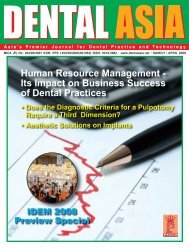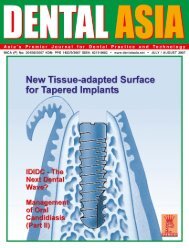Download - Dental Asia
Download - Dental Asia
Download - Dental Asia
You also want an ePaper? Increase the reach of your titles
YUMPU automatically turns print PDFs into web optimized ePapers that Google loves.
CLINICALFEATURE<br />
by Dr George Freedman<br />
Eliminating<br />
<strong>Dental</strong> Stains<br />
<strong>Dental</strong> stains are of great concern to the vast majority of the population.<br />
Tooth discoloration has been made socially and culturally unacceptable by<br />
the ubiquitous presence of bright, white smiles on television, in films, and<br />
the print media. From a professional perspective, dental stains contribute to<br />
plaque accumulation, the increased retention of bacteria and their associated acidic<br />
environment, and eventually, to tooth demineralization and decay. The elimination of<br />
dental stains by the dentist and the auxiliary staff on a regular basis (twice per year)<br />
has contributed greatly to the improvement of dental health in the general<br />
population over the past 50 years.<br />
As patients have become more aware of their own dental health, they have<br />
increasingly demanded not only healthier teeth, but healthier-looking teeth as well.<br />
Typically, more than 80% of individuals surveyed indicate an active interest in the<br />
whiteness (and thus an active concern for discoloration) of their teeth. The<br />
appearance of non-stained teeth is the major visible component of dental health,<br />
and as such, is used by patients to gauge their oral health and hygiene. Routine<br />
scaling and prophylaxis, on a bi-annual basis, is well accepted by both<br />
professionals and the public, and is effective in the removal of dental stain at least<br />
for a short time after the recare visit. However, the daily accumulation of dental<br />
stain, particularly after meals, is a recurrent problem that is more difficult to address.<br />
When these stains accumulate in public situations where the dental appearance is<br />
an important factor, they can adversely affect the outcome of the event, whether<br />
business or social.<br />
Certainly, brushing and flossing after eating<br />
can eliminate the most obvious<br />
discolorations, but these activities are not<br />
always practical, particularly in the typical<br />
restaurant or home setting of most meals. It<br />
would be preferable to have a relatively<br />
innocuous, but effective, destaining<br />
procedure that can be readily accomplished,<br />
unobtrusively and quickly, even under<br />
conditions of intense public scrutiny. Most<br />
people, consciously or subconsciously, tend<br />
to wipe their tongues across their anterior<br />
teeth to remove stains, but without a<br />
dentifrice agent, this action is largely<br />
ineffective.<br />
Figure 1 SuperSmile Quikee dentifrice<br />
The objective of this clinical study was to<br />
examine the effects of a commercially-available dentifrice (SuperSmile Quikee)<br />
upon the removal of food induced dental stains (Figure 1). This study was designed<br />
to objectively evaluate the immediate effect of SuperSmile Quikee on recently<br />
30 <strong>Dental</strong> <strong>Asia</strong> • May / June 2008





